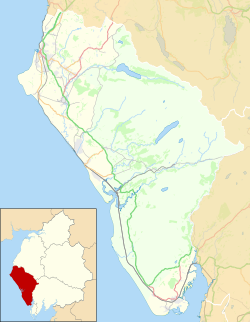| Calder Bridge | |
|---|---|
 Main road through Calder Bridge | |
Location within Cumbria | |
| OS grid reference | NY0406 |
| Civil parish | |
| Unitary authority | |
| Ceremonial county | |
| Region | |
| Country | England |
| Sovereign state | United Kingdom |
| Post town | SEASCALE |
| Postcode district | CA20 |
| Dialling code | 01946 |
| Police | Cumbria |
| Fire | Cumbria |
| Ambulance | North West |
| UK Parliament | |
Calder Bridge (also Calderbridge) is a small village in Cumbria in England. It is located between the hamlets of Gosforth and Beckermet and lies on the River Calder. [1]
Contents
It is around 1 mile northeast from the Sellafield nuclear plant— Calder Hall Nuclear Power Station was the world's first major nuclear power station when it opened in 1956. [2] The village contains the Grade II listed St Bridget's Church, the Grade II listed Pelham House (formerly Ponsonby Hall) and the Stanley Arms inn.


